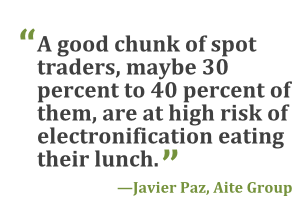A widening probe of the foreign-exchange market is roiling an industry already under pressure to reduce costs as computer platforms displace human traders.
Electronic dealing, which accounted for 66 percent of all currency transactions in 2013 and 20 percent in 2001, will increase to 76 percent within five years, according to Aite Group LLC, a Boston-based consulting firm that reviewed Bank for International Settlements data. About 81 percent of spot trading—the buying and selling of currency for immediate delivery—will be electronic by 2018, Aite said.
“Foreign-exchange traders are much like stock floor traders: a rapidly dying breed,” said Charles Geisst, author of “Wall Street: A History” and a finance professor at Manhattan College in Riverdale, New York. “Once the banks realize they are costing them money, the positions will dwindle quickly.”
Complete your profile to continue reading and get FREE access to Treasury & Risk, part of your ALM digital membership.
Your access to unlimited Treasury & Risk content isn’t changing.
Once you are an ALM digital member, you’ll receive:
- Thought leadership on regulatory changes, economic trends, corporate success stories, and tactical solutions for treasurers, CFOs, risk managers, controllers, and other finance professionals
- Informative weekly newsletter featuring news, analysis, real-world case studies, and other critical content
- Educational webcasts, white papers, and ebooks from industry thought leaders
- Critical coverage of the employee benefits and financial advisory markets on our other ALM sites, PropertyCasualty360 and ThinkAdvisor
Already have an account? Sign In Now
*May exclude premium content© 2025 ALM Global, LLC, All Rights Reserved. Request academic re-use from www.copyright.com. All other uses, submit a request to [email protected]. For more information visit Asset & Logo Licensing.





